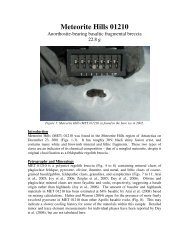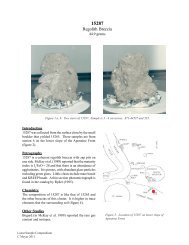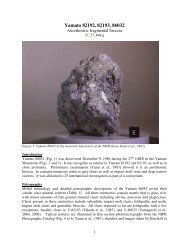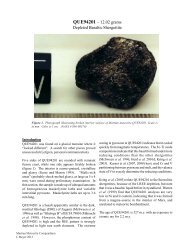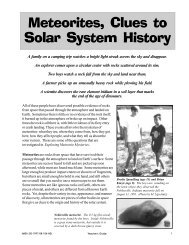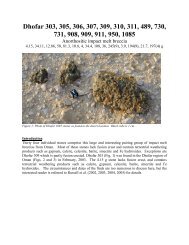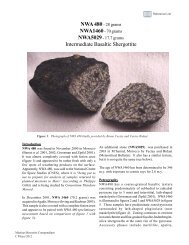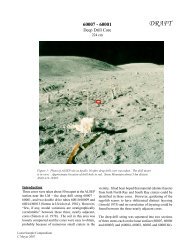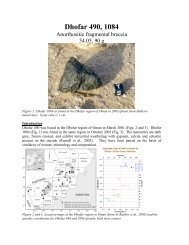Moore County Unbrecciated Cumulate Eucrite, 1.88 kg
Moore County Unbrecciated Cumulate Eucrite, 1.88 kg
Moore County Unbrecciated Cumulate Eucrite, 1.88 kg
You also want an ePaper? Increase the reach of your titles
YUMPU automatically turns print PDFs into web optimized ePapers that Google loves.
Plagioclase: <strong>Moore</strong> <strong>County</strong> plagioclase occurs primarily as large grains dispersed throughout the<br />
meteorite (Henderson and Davis, 1936; Hess and Henderson, 1949), but also as minute euhedral<br />
inclusions in pyroxene (Figure 8), both with similar compositions (Mittlefehldt, 1990). Henderson and<br />
Figure 9: Rare-earth element patterns in <strong>Moore</strong> <strong>County</strong> pyroxenes; graphs from Schnetzler and Philpotts<br />
(1969) (top) and Hsu and Crozaz (1997) (bottom).<br />
Davis (1936) originally reported strongly cleaved plagioclase in their analysis of <strong>Moore</strong> <strong>County</strong> mineral<br />
separates, but this is contradicted by a lack of plagioclase cleavage found in the first thin section analysis<br />
(Hess and Henderson, 1949). These initially-reported cleavages may be curved, conchoidal fracture<br />
planes (Hess and Henderson, 1949) that were not immediately obvious from macroscopic observations.<br />
Numerous chemical analyses (e.g., Henderson and Davis, 1936; Duke and Silver, 1967; Hostetler and<br />
Drake, 1978; Tagai et al, 1994; Pun et al, 1997; Mayne et al, 2009) give a range of compositions from<br />
An89-An93. Al/Si ordering was attained in the tetrahedral sites ~94% (Tagai et al, 1994). There is no<br />
observable zoning (Hess and Henderson, 1949; Hostetler and Drake, 1978) but some crystals show latestage<br />
alteration to less calcic plagioclase (Hess and Henderson, 1949). Plagioclase in <strong>Moore</strong> <strong>County</strong> is the<br />
least calcic among the cumulate eucrites (Tera et al, 1997).<br />
Plagioclase twins are predominantly of albite, pericline, and manebach varieties, with no reported<br />
Carlsbad twinning (Hess and Henderson, 1949).<br />
The larger plagioclase grains contain numerous minute inclusions (Henderson and Davis, 1936). These<br />
include (1) minute blebs and spherical particles of metal along fracture planes (Hess and Henderson,<br />
1949), (2) faintly pink, Fe-rich isotropic, translucent crystals with an index of refraction between feldspar<br />
and tridymite (Hess and Henderson, 1949; Hostetler and Drake, 1978), (3) elongated, rhombohedral,<br />
brownish-red crystals (Henderson and Davis, 1936), (4) spherical reddish crystals (Henderson and Davis,<br />
1936), and (5) slender, uniform, prismatic crystals arranged in rows along cleavage (Henderson and<br />
Davis, 1936). None of these inclusions have been analyzed chemically or mineralogically by more recent<br />
authors.<br />
10




